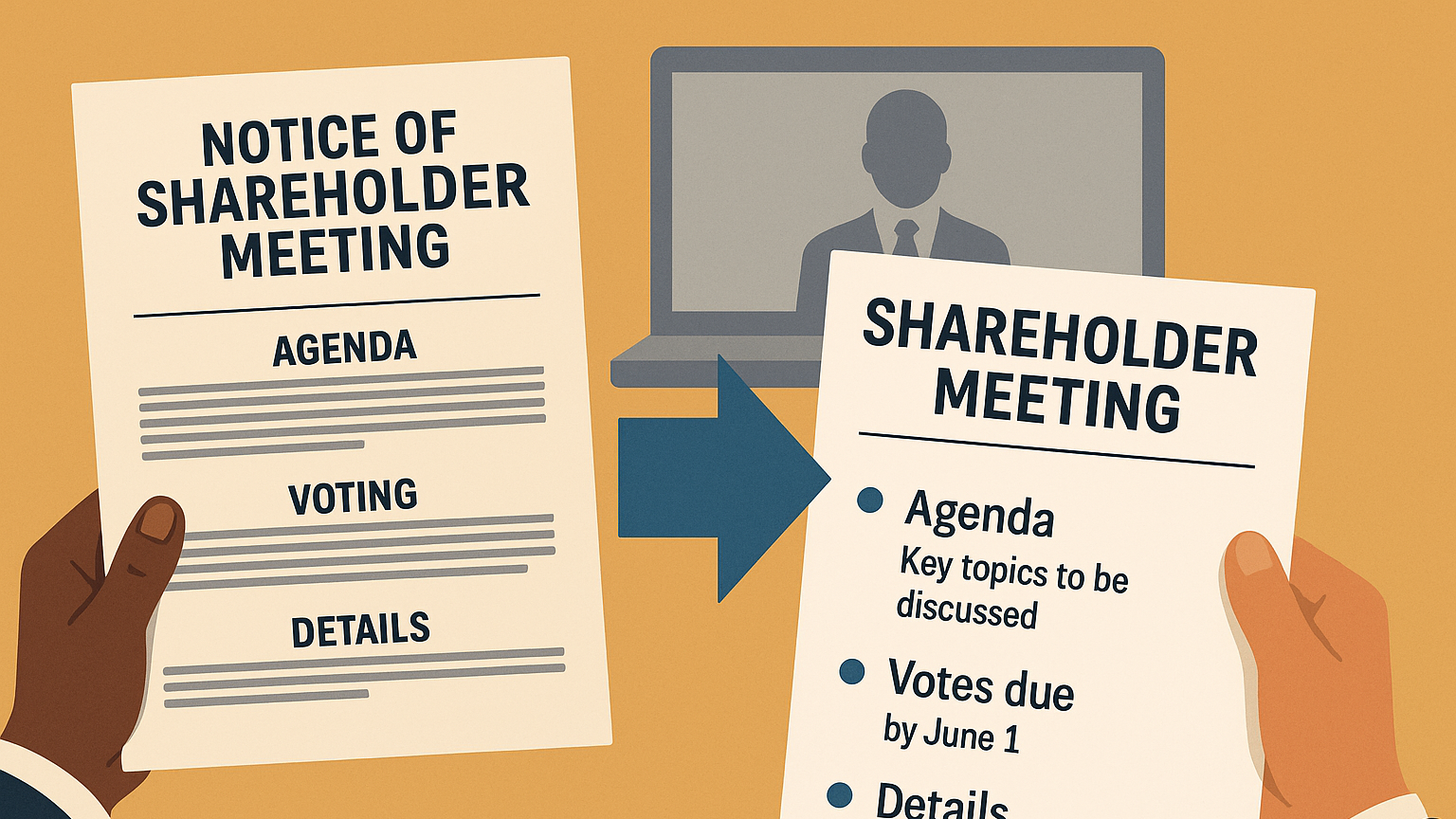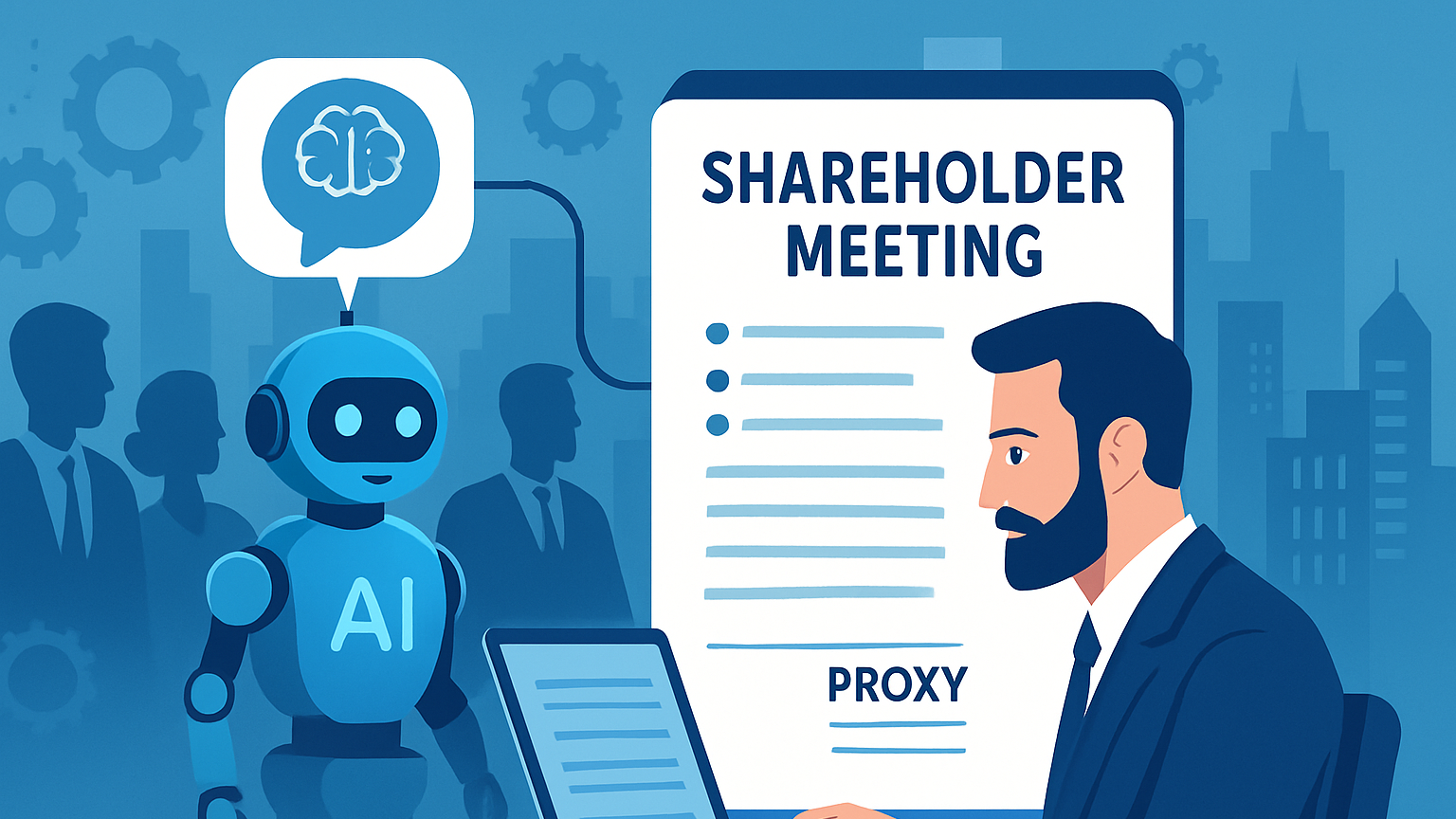
AI in Shareholder Meeting Announcements for Corporate Governance and Business Leaders
You’re operating in a world where information moves fast, expectations from shareholders are high, and regulatory scrutiny is constant. AI is rapidly reshaping how you create, distribute, and manage shareholder meeting announcements — from drafting legally compliant notices to personalizing outreach and logging auditable trails. This article gives you focused, practical guidance for using AI in shareholder meeting announcements so you can increase productivity, reduce risk, and keep governance standards high.
Why shareholder meeting announcements matter to you
Shareholder meeting announcements are more than a calendar entry; they’re legal notices, investor communications, and governance milestones. When you publish a notice, you’re meeting statutory requirements, protecting the company from disputes, and shaping how shareholders perceive leadership. You need accuracy, timeliness, and clarity — and any slip can cause regulatory risk, shareholder dissatisfaction, or reputational damage. Using AI intelligently helps you handle volume, complexity, and stakeholder expectations while preserving the legal safeguards you must maintain.
The AI opportunity in regulatory notices and filings
AI gives you tools to automate repetitive tasks, surface risks, and improve the way notices are composed and reviewed. For regulatory filings and corporate governance notices, that means faster drafting, automatic cross-referencing to prior filings, and validation against legal requirements. You get consistent formatting, improved language clarity, and suggestions for missing disclosures. When deployed with the right controls, AI can accelerate cycles so you get notices out on time and with fewer manual errors, letting you focus your human capital where judgment matters most.
Core AI capabilities that apply to shareholder meeting announcements
Natural language generation (NLG) for drafting and templating
NLG systems help you draft announcements using templates and data feeds. You can generate a legally oriented notice from a board resolution, populate dates, agenda items, quorum requirements, and proxy instructions automatically. These engines let you keep a consistent corporate voice while adapting language to jurisdictional requirements. When you use NLG well, you reduce drafting time and ensure that standardized language is used across all notices — with human review as the final safety check.
Natural language processing (NLP) for review and compliance checking
NLP helps you analyze existing documents and spot inconsistencies, missing disclosures, or regulatory triggers. Named entity recognition can identify references to governance items, dates, or legal citations that must be accurate. Classification models can flag whether a notice contains necessary elements such as proxy voting instructions or special resolutions. These capabilities reduce review cycles and help you catch issues that could lead to noncompliance.
Summarization and plain-language conversion
You can use AI to create two forms of the same notice: a legally precise version and a plain-language summary for retail shareholders. Automated summarization extracts key agenda points, voting deadlines, and meeting logistics into a short, readable format suitable for email or web announcements. Plain-language conversion tools can make dense legal wording accessible, improving shareholder engagement without replacing the legal notice itself.

Translation and localization
Cross-border corporations need notices in multiple languages and sometimes local legal forms. AI-driven translation and localization let you convert announcements quickly while preserving legal terms and formatting. Neural translation models can be tuned for financial and legal language so your translated notices carry the intended meaning and tone. You should still use legal review for jurisdiction-specific legal phrasing, but AI greatly reduces the initial cost and time.
Sentiment analysis and stakeholder prioritization
AI can analyze shareholder communications, proxy advisors’ statements, and public commentary to gauge sentiment and identify activist risk or hot-button governance issues. This insight helps you prioritize who receives tailored communications and what messaging to emphasize. You’ll gain early warning signals before meetings, letting you prepare board responses or adjust the agenda.
Document summarization for internal workflows
Internally, you’ll want a single source of truth for agendas, appendices, and proxy materials. AI can auto-summarize long materials, providing executives and board members with condensed briefings that highlight decisions, dissent, and required actions. This helps your leadership prepare for meetings without wading through dozens of pages.
Practical use cases for AI in shareholder meeting announcements
Automated generation of draft notices and agendas
You can automate the creation of draft notices from structured inputs like board minutes, resolutions, and corporate calendars. When a board schedules a meeting, the AI system uses your templates and fills in statutory notice periods, proposed resolutions, and proxy language. That draft is then routed for legal and board review. The result is a faster, repeatable process that reduces drafting bottlenecks and improves consistency.

Compliance checking against regulatory checklists
AI can validate notices against jurisdictional checklists: required notice period, content of proxy statements, quorum rules, and shareholder rights disclosures. By maintaining an up-to-date rule base, AI flags omissions or language that may run afoul of securities laws or listing rules. This reduces late-stage surprises and helps your counsel focus on substance rather than form.
Personalization and targeted shareholder outreach
Not all shareholders are the same: institutional investors, retail holders, and activists have different needs. AI-driven segmentation helps you tailor summaries, Q&A content, or reminders to specific groups. You can personalize content based on share ownership, engagement history, or language preferences, improving turnout and satisfaction while maintaining a compliant trail of communications.
Accessibility and format conversion
Accessibility is no longer optional. AI can convert notices into accessible formats — tagged PDFs, HTML with ARIA attributes, or audio summaries — ensuring compliance with accessibility guidelines and broadening shareholder participation. Automated generation of alt text for charts and clear headings for screen readers helps you reach shareholders with disabilities.
Proxy management and secure voting facilitation
AI systems can integrate with electronic voting platforms to manage proxy instructions, provide reminder notifications, and analyze voting patterns. Machine learning models can predict turnout and voting behavior, helping you plan logistics and communication cadence. AI also supports multi-factor authentication and secure ballot handling to protect the integrity of voting processes.

Real-time assistance during meetings
During virtual or hybrid shareholder meetings, AI-powered assistants can transcribe Q&A, tag questions by topic, and generate suggested responses for management. You can use moderation tools that filter inappropriate content, expedite queueing of questions, and provide instant summaries to the chair. These capabilities improve the meeting flow and ensure key topics aren’t missed.
Post-meeting documentation: minutes, transcripts, and filings
After the meeting, AI can generate minutes from transcribed audio, extract resolutions passed, and prepare filing drafts for regulatory bodies. This reduces administrative lag and ensures the post-meeting record is consistent with what occurred. You still want human sign-off for legal filings, but AI accelerates the preparation and reduces the risk of omission.
Sentiment and stakeholder trend analysis
AI can track trends across meetings, filings, and shareholder communications to spot recurring concerns — for example, repeated queries about executive compensation or sustainability. This analysis informs board strategy and helps you proactively address shareholder questions in future notices and meetings.
Implementation considerations and risk controls
Data quality and structured inputs
AI performs best when it has reliable, structured data. You’ll want standardized templates, consistent metadata tagging, and governance over how inputs like resolutions and dates are captured. Clean data reduces hallucination risk and improves the precision of generated notices. Establish input standards early so AI can generate reliable drafts.
Integration with document management and governance systems
Attach AI tools to your legal document management system (DMS), council workflows, and investor relations platforms. Integration ensures version control, audit trails, and seamless routing for approvals. Without this integration, you risk fragmentation, inconsistent records, and compliance gaps — which are especially problematic when you must demonstrate adherence to notice requirements.
Security, privacy, and confidentiality
Shareholder notices often include confidential board decisions or sensitive corporate data. You must ensure AI vendors and internal systems comply with your security policies: encryption in transit and at rest, access controls, and secure logging. When using cloud-based AI services, understand whether data is retained, how models are trained, and whether prompts or outputs might be used to improve vendor models.
Explainability and audit trails
Boards and regulators may require you to explain how a notice was produced or why specific language was chosen. Maintain logs that show input data, template versions, model parameters, and human review steps. Explainable AI tools — or simply auditable processes that document human approvals — help you meet governance standards.
Human-in-the-loop review and legal sign-off
AI should augment, not replace, legal judgment. Maintain mandatory human reviews, especially for statutory notices and filings. Define approval authorities and create checkpoints where legal counsel and the board confirm language. You’ll reduce legal risk while benefiting from AI’s efficiency.
Model governance and periodic validation
Treat AI models like financial controls: define ownership, test accuracy, validate outputs periodically, and track performance over time. Ensure that somebody in your governance team is responsible for model updates, compliance monitoring, and remediation when issues arise.
Legal and regulatory risks to manage
Jurisdictional compliance and securities law nuance
Different jurisdictions have different notice requirements. AI can help, but it’s not a substitute for jurisdiction-specific legal expertise. You must ensure that model templates reflect local laws, stock-exchange rules, and company charter provisions. In complex cross-border cases, involve local counsel before finalizing notices.
Liability for AI-generated errors
If an AI-generated notice contains incorrect dates, omissions, or misleading information, who is liable? You must allocate responsibility in internal policies and vendor contracts. Maintain human signoff and retain versioned logs so you can show due diligence and mitigations if issues arise.
Insider information and data handling
Notices can reveal or be generated from material non-public information. Ensure your AI processes respect insider trading policies and restrict access appropriately. Controls should prevent inadvertent disclosure through drafts, prompts, or integrated analytics.
Personal data protection and privacy laws
When AI personalizes outreach or analyzes shareholder profiles, you handle personal data. Ensure compliance with GDPR, CCPA, and local privacy laws. Obtain necessary consents, document lawful bases for processing, and secure data subject rights mechanisms.
Record-keeping and retention requirements
Regulators often require you to keep notices and related communications for specified periods. AI systems should support retention policies, exportable audit logs, and tamper-evident storage. Ensure records are discoverable and can be delivered during inspections or litigation.
Governance and policy around AI use
Define clear policies and roles
Set policies that define permissible AI use cases for notices, who may approve content, and what oversight is required. Assign clear roles: AI model owner, data steward, legal approver, and compliance monitor. These roles help you maintain accountability.
Ethical guidelines and fairness
AI can inadvertently introduce bias — for instance, in targeted communications or automated responses. Establish ethical guidelines for fairness and nondiscrimination, and audit personalization mechanisms to ensure certain groups aren’t unfairly excluded or overloaded with communications.
Incident response and escalation
Create protocols for AI failures: incorrect notices, data breaches, or model misbehavior. Define escalation paths to legal, IR, and the board. Practice tabletop exercises so your team can respond quickly when automation goes wrong.
Training and awareness for the organization
Train legal, IR, and corporate secretariat teams on how AI works, its limitations, and their responsibilities. This builds trust, reduces misuse, and increases the effectiveness of AI tools in your workflows.
Steps to adopt AI for shareholder meeting announcements
Start with a clear roadmap and pilot
Begin with a pilot on a low-risk element: draft plain-language summaries or generate internal briefings. Measure time saved, accuracy, and stakeholder satisfaction. Use lessons from the pilot to expand AI to more sensitive tasks like notice drafting and proxy statements.
Engage stakeholders early
Involve legal, investor relations, compliance, IT, and the board in planning. Their input shapes templates, approval workflows, and security requirements. Early involvement reduces pushback and ensures the AI solution meets real operational needs.
Define success metrics and KPIs
Set metrics: reduction in drafting time, fewer notice errors, better shareholder engagement rates, or cost per notice. Track them regularly and align them with governance objectives like compliance and transparency.
Build robust workflows with human approvals
Design flows that combine AI generation with mandatory human review. Ensure approvals are logged and stored. Automate routing but never remove legal sign-off for statutory documents.
Vendor selection, procurement, and contracting
Choose vendors who understand regulatory contexts, demonstrate security controls, and commit to clear data-use policies. Get contractual assurances about data retention, model training, and liability. Negotiate SLA terms for availability and incident response.
- Look for vendors that offer model explainability, on-premise or private cloud options, and contractual controls on data usage.
Train models and maintain templates
Tune models on your specific language and templates. Maintain a library of approved templates and version them carefully. Retrain or retune periodically with new regulatory language or corporate changes.

Vendor selection checklist (brief)
When you evaluate AI vendors, prioritize security certifications, legal-domain expertise, data residency options, explainability features, and clear contractual terms regarding data usage and model training. Consider vendors that allow private deployments, offer robust APIs for DMS integration, and provide support for compliance audits and validation.
Best practices for day-to-day operations
Maintain a single source of truth
Keep contract templates, shareholder registers, and historical notices in a governed repository. AI should read from and write to that repository so you avoid contradictory records and preserve auditability.
Keep human judgment central
Use AI to prepare drafts, summaries, and recommendations, but make human review and legal approval mandatory. That balances efficiency with compliance and accountability.
Monitor, measure, and improve
Track model performance: error rates, human corrections, and regulatory issues. Use this feedback to refine templates, retrain models, or change workflows. Continuous improvement keeps AI systems aligned with evolving requirements.
Document everything
Log input data, versions of templates, approvals, and final distributions. Good logs protect you in audits, reveal root causes of issues, and support internal governance.
Measuring success: KPIs and outcomes
Efficiency and cost metrics
Measure time-to-issue for notices, reduction in drafting hours, and operational cost savings. These tangible benefits justify investment and show ROI to leadership.
Compliance and error reduction
Track the number of compliance findings, regulatory inquiries, or corrected notices. A decrease shows improved rigor and fewer legal distractions.
Shareholder engagement metrics
Monitor open rates, attendance rates at meetings, and voting participation. Better personalization and clearer notices typically increase these metrics.
Risk and incident metrics
Track security incidents, AI-generated errors, and escalation frequency. Low incident rates with quick remediation indicate strong governance.
Future trends and what you should watch
Generative AI and multimodal notices
Expect AI to generate integrated notices that combine text, audio, and visuals — and to create adaptive, interactive notices for shareholders. You’ll be able to provide dynamic summaries or on-demand briefings tailored to user preferences.
Stronger regulatory focus on AI in disclosures
Regulators are increasingly interested in how AI is used in corporate communications. You should anticipate more guidance on AI transparency and model governance and align early so you’re not scrambling to comply later.
Explainable and auditable models
Demand for explainability will grow. Vendors will provide features that track why a model suggested particular language or identified a risk. You should prefer tools that make outputs traceable and defensible.
Integration with governance, risk, and compliance (GRC) platforms
AI-enabled notices will be part of broader GRC ecosystems that connect board agendas, risk registers, and compliance tasks. This holistic view helps boards make more informed decisions and demonstrates strong governance practices.
Ethical and reputational considerations
Transparency with shareholders
Be transparent about how you use AI in communications. Explain what’s automated and what has human review. Transparency builds trust and reduces the risk of backlash if errors occur.
Avoiding manipulative personalization
Personalization can improve engagement, but avoid manipulative targeting that obscures material information. Keep legal notices clear and equal — personalized content should supplement, not replace, statutory language.
Equal access and inclusion
Make sure AI-driven personalization doesn’t exclude segments of your shareholder base. Ensure accessible formats and multiple channels so all shareholders can participate.
Practical examples and mini case studies
Public company with global shareholder base
Imagine you manage IR for a multinational listed company. You use AI to generate a master notice, translate it into multiple languages, and localize legal phrases. Proxy materials are summarized for retail shareholders and pushed via a personalized email cadence. Voting turnout increases, legal review time drops, and you maintain a clear audit trail for regulators and exchanges.
Mid-size private company preparing an annual meeting
If you’re running secretariat functions for a private company, AI helps you create plain-language meeting notices and minutes from board transcripts. You reduce administrative time and improve record accuracy. The board appreciates concise AI-generated briefings that cut prep time.
Reactive scenario with activist engagement
In a case of activist engagement, AI helps by analyzing public filings and social commentary to anticipate agenda items and sentiment. You use targeted outreach to institutional holders, prepare more detailed Q&A materials, and adjust agenda language to address concerns. AI gives you speed and insights during a high-pressure period.
Common pitfalls and how to avoid them
Over-reliance without governance
Relying on AI without human oversight or adequate policies creates legal risk. Prevent this with mandatory approvals, documented workflows, and training.
Poorly managed data sources
If you feed AI inconsistent or outdated data, outputs will be unreliable. Use cleaned, versioned, and governed sources for templates and shareholder information.
Ignoring minority jurisdictions and languages
Failing to account for local legal phrases or small-jurisdiction rules leads to errors. Use local counsel in addition to AI translation for legal notices.
Vendor lock-in and hidden data usage
Avoid vendors whose contracts allow them to reuse your data to further train public models unless you explicitly consent. Prioritize contracts that protect your data and allow portability.
Checklist to get started (concise)
Begin by mapping current workflows and pain points, select a pilot use case (e.g., draft notices or summaries), assemble a cross-functional team, define success metrics, choose a vendor or build in-house with clear data governance, run a controlled pilot with human oversight, and iterate based on performance and stakeholder feedback.
Final recommendations for you
Start pragmatic and iterative: pick a single, well-scoped use case, apply strong human-in-the-loop controls, and measure results. Keep legal review central, document everything, and choose vendors who respect data and governance needs. As you scale, integrate AI into your GRC landscape and keep refining model governance so AI remains an enabler, not a liability.
You’ve got the opportunity to use AI to make shareholder meeting announcements faster, clearer, and more inclusive — without compromising governance or compliance. With careful planning, human oversight, and the right technology choices, AI can reduce mundane work and give your legal and IR teams time to focus on strategy and shareholder relationships.
If you found this helpful, please clap the article, leave a comment with any questions or experiences you want to share, and subscribe to my Medium newsletter for updates and practical guides on AI for governance and legal teams.
